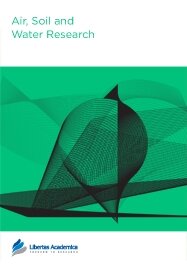

Publication Date: 15 Jan 2009
Type: Original Research
Journal: Air, Soil and Water Research
Citation: Air, Soil and Water Research 2009:2 1-14

Vladimír Kočí1, Tomáš Ocelka2 and Roman Grabic2
1Department of Environmental Chemistry, ICT Prague, Technicka 5, 166 28 Prague 6, Czech Republic. 2Institute of Public Health Ostrava, National Reference laboratory for POPs, Partyzanske nam. 7, 702 00 Ostrava, Czech Republic.
Abstract
Persistent compounds are present around almost the entire world. The level of contamination in very old groundwater sources (Cennoman bedrock Mesozoic, approximately 100 million years old) was assessed. This offers an information about realistic natural background. Together with chemical analysis a toxicity evaluation of sampled sites was performed. Semipermeable membrane devices were applied as a sampling system. Exposed SPMDs were analyzed both for chemical contain of POPs and toxicity properties. The chemical analyses of PAHs were made by HPLC-FLD, PCBs and OCPs were analysed by GC/MS/MS on GCQ or PolarisQ (Thermoquest). Toxicity bioassays on alga Desmodesmus subspicatus, bacteria Vibrio fischeri and crustacean Daphnia magna was performed. The results show very low contamination of groundwater with POPs with concentrations close to detection limits of applied analytical tools. Even this low contamination was possible to rank based on the obtained toxicity data. Toxicity proved to be a good parameter for determination of relative POPs contamination where concentration is near to detection limits and thus correct determination of all POPs cannot be undertaken. Although contamination levels were found to be very low, a secondary contamination of PCBs through the bedrock was observed. Organochlorine pesticides were found at a sampling site near a mouth of the ground watershed. Applied toxicity tests confirmed the presence of toxic substances and marked sites of higher contamination. Application of toxicological parameter Vtox allowed the ranking of assessed sites by their contamination level even in cases where concentrations of pollutants were near or under detection limits and it was not therefore possible to rank the sites on the basis of chemical parameters. Toxicity response of bioassays obtained on SPMDs exposed in clean groundwater can be used as a background toxicity values for further SPMD applications. Secondary contamination with PCBs and pesticides was detected in Cennoman groundwater. Toxicity evaluation of SPMD extract can be used as an effective tool for ranking of general level of water contamination.
PDF (496.19 KB PDF FORMAT)
RIS citation (ENDNOTE, REFERENCE MANAGER, PROCITE, REFWORKS)
BibTex citation (BIBDESK, LATEX)

Publishing in Air, Soil and Water and Water Research was the best experience I have had so far in an academic context. The review process was fair, quick and efficient. I congratulate the team at Libertas Academica for a very well managed journal.

All authors are surveyed after their articles are published. Authors are asked to rate their experience in a variety of areas, and their responses help us to monitor our performance. Presented here are their responses in some key areas. No 'poor' or 'very poor' responses were received; these are represented in the 'other' category.See Our Results
Copyright © 2013 Libertas Academica Ltd (except open access articles and accompanying metadata and supplementary files.)
Facebook Google+ Twitter
Pinterest Tumblr YouTube